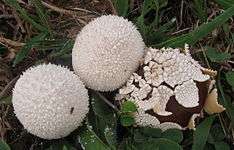Lycoperdon marginatum
Lycoperdon marginatum, commonly known as the peeling puffball, is a type of puffball mushroom in the genus Lycoperdon. A common species, it is found in Europe and North America, where it grows on the ground. It is characterized by the way that the spiny outer layer peels off in sheets.
| Lycoperdon marginatum | |
|---|---|
 | |
| Scientific classification | |
| Kingdom: | |
| Division: | |
| Class: | |
| Order: | |
| Family: | |
| Genus: | |
| Species: | L. marginatum |
| Binomial name | |
| Lycoperdon marginatum Vittad. (1839) | |
Taxonomy
The species was first described scientifically in 1839 by Vittadini.[1] Molecular analysis places it the species in the subgenus Lycoperdon of the genus Lycoperdon, along with L. perlatum and L. norvegicum.[2]
Description
The fruit bodies of Lycoperdon marginatum are roughly spherical when young, becoming flattened and more pear-shaped in maturity, and have dimensions of 1–5 cm (0.4–2.0 in) wide. A short, tapering stalk holds the fruit body. Initially white, the surface of the peridium (spore case) is densely covered with short spines; the spines eventually fall off in irregular sheets, exposing the smooth, brown underlying surface. Mature fruit bodies form a small opening at the top through which spores are released. The internal spore-bearing tissue, the gleba, is initially white and firm, but becomes greenish-brown and then greyish-brown and powdery at the mushroom matures. The spores are spherical, covered with minute warts, and measure 3.5–4.5 μm.[3] It has yellowish-brown capillitium threads that have a few pores or septa, and measure 6–7 μm wide.[4]
The edibility of the puffball is not known with certainty, and there have been conflicting reports in this regard, with some listing it as safe to eat,[5] and others described it as poisonous.[3] The species is used in Mexico to produce auditory hallucinations, although chemical analysis of fruit bodies as not revealed the presence of any substances that would cause this effect.[6]
Lycoperdon echinatum is similar is appearance, but its spines do not break off in sheets.[3] The exoperidium of L. rimulatum sometimes peels off in sheets, but it does not have spines on its surface.[6]
Habitat and distribution
The puffball is saprobic, and grows on the ground singly, scattered, or in groups. A fairly common species, it is often found on sandy soil, in nutrient-poor locations, or in oak-pine woods, where it fruits between June and December.[3] It is found in Australia,[7] Europe and North & South America.
The puffball was featured on a postage stamp from the Ascension Islands in 1983.[8]
References
- Moris GG, de Notaris J (1839). Florula Caprariae (in Latin). Turin, Italy: Ex Regio Typographeo. p. 226.
- Larsson E, Jeppson M (2008). "Phylogenetic relationships among species and genera of Lycoperdaceae based on ITS and LSU sequence data from north European taxa". Mycological Research. 112: 4–22. doi:10.1016/j.mycres.2007.10.018. PMID 18207380.
- Bessette AE, Roody WC, Bessette AR (2007). Mushrooms of the Southeastern United States. Syracuse, New York: Syracuse University Press. pp. 316–7. ISBN 978-0815631125.
- Ellis JB, Ellis MB (1990). Fungi without Gills (Hymenomycetes and Gasteromycetes): An Identification Handbook. London, UK: Chapman and Hall. p. 238. ISBN 0-412-36970-2.
- Phillips, Roger (2010). Mushrooms and Other Fungi of North America. Buffalo, NY: Firefly Books. pp. 332–33. ISBN 978-1-55407-651-2.
- Arora D. (1986). Mushrooms Demystified: A Comprehensive Guide to the Fleshy Fungi. Berkeley, California: Ten Speed Press. pp. 694–5. ISBN 0-89815-169-4.
- May TW, Milne J, Shingles S, Jones RH (2008). Fungi of Australia. CSIRO Publishing. p. 121. ISBN 978-0643069077.
- Moss MO. (1998). "Gasteroid Basidiomycetes on postage stamps". Mycologist. 12 (3): 104–6. doi:10.1016/S0269-915X(98)80005-0.
External links
| Wikimedia Commons has media related to Lycoperdon marginatum. |